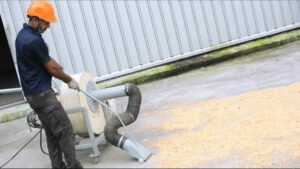8 Ways to Eliminate Dust in Packaging Systems
Dust and other types of particulate can potentially cause a problem for packaging machines. Products such as protein powders, flour, dry snacks, or ground coffee can generate dust in packaging environments.
You’re most likely to encounter dust when powdered or dry product passes through certain transfer points throughout the packaging system. Any time the product is in motion or starts and stops suddenly, the process may generate dust.
Here are eight innovative features in modern packaging machines that can help prevent or eliminate dust buildup.
1. Enclosed Jaw Drives
If your packaging machines operate in a dusty environment or work with a dusty product, it’s necessary for the components of the sealing jaws to remain protected from particulates.
Packaging machines designed for wet or dusty environments will typically have a completely enclosed jaw drive to keep particulate from building up on the parts.
2. Dust-Proof Enclosures
Enclosures that contain electrical or pneumatic components need to have sufficient protection against dust buildup to function properly. When buying packaging machines for a dusty environment, you should make sure the equipment has an Ingress Protection (IP) Rating that’s intended for your application. An IP Rating is made of two numbers that indicate how dust- and water-tight an enclosure is.
For dust protection, you should get packaging machinery with an IP Rating of 50 or higher. If you need dust-tight enclosures choose machinery with an IP Rating of 60 or higher.
3. Dust Removal Machines
Dust buildup isn’t the only thing you should worry about. Dust can also get into package seams, which can cause inadequate uniformity during the heat seal process that can result in lost product. To avoid this, you can set up dust removal equipment at multiple points throughout a facility to recirculate dust and expel it from the environment.
4. Static Elimination Bars
When plastic packaging film is unwound and fed through the packaging machinery, it can generate static electricity, which in turn causes dust and other particulates to stick to the inside of the film. This can cause product to appear in the package seals, which can compromise the integrity of the package. A static elimination bar can help further avoid these complications.
5. Dust Hoods
Automatic pouch filling machines can benefit from a dust hood placed over the product dispensing station. This can help to collect and remove particulates as the product drops from the filter into the bag.
6. Vacuum Pull Belts
Friction pull belts are standard for vertical form fill and seal machines. They are responsible for pulling the packaging film through the system using friction. However, if the environment is dusty, particulates can get between the film and the friction pull belts, resulting in poor performance and wearing them down over time.
On the other hand, vacuum pull belts use vacuum suction instead of friction, which effectively eliminates the concern over dust buildup. They may be more expensive than friction pull belts, but they’re likely to last much longer and result in less of a risk for production lines.
7. Continuous Motion Packaging
Packaging equipment can function in either intermittent or continuous motion. Continuous motion is more ideal in dusty environments because of the downward airflow that keeps the product-generated dust inside the packaging.
8. Regular Preventative Maintenance
In addition to dust controlling measures, regular preventative maintenance is another great way to further eliminate dust from packaging systems. This includes cleaning and inspecting components for residue or dust.
All of these can help you combat dust in work environments, keeping products and equipment protected.





